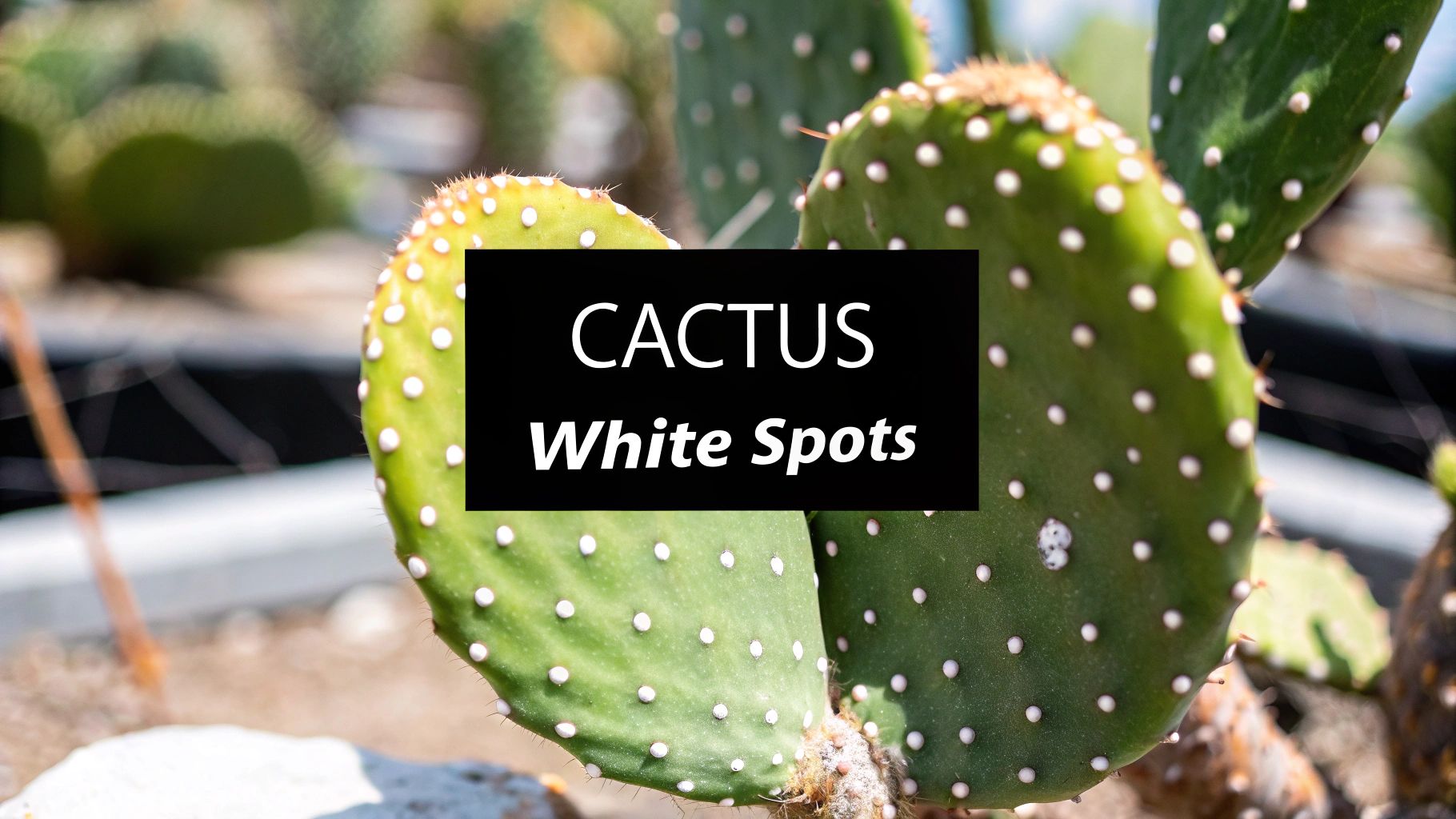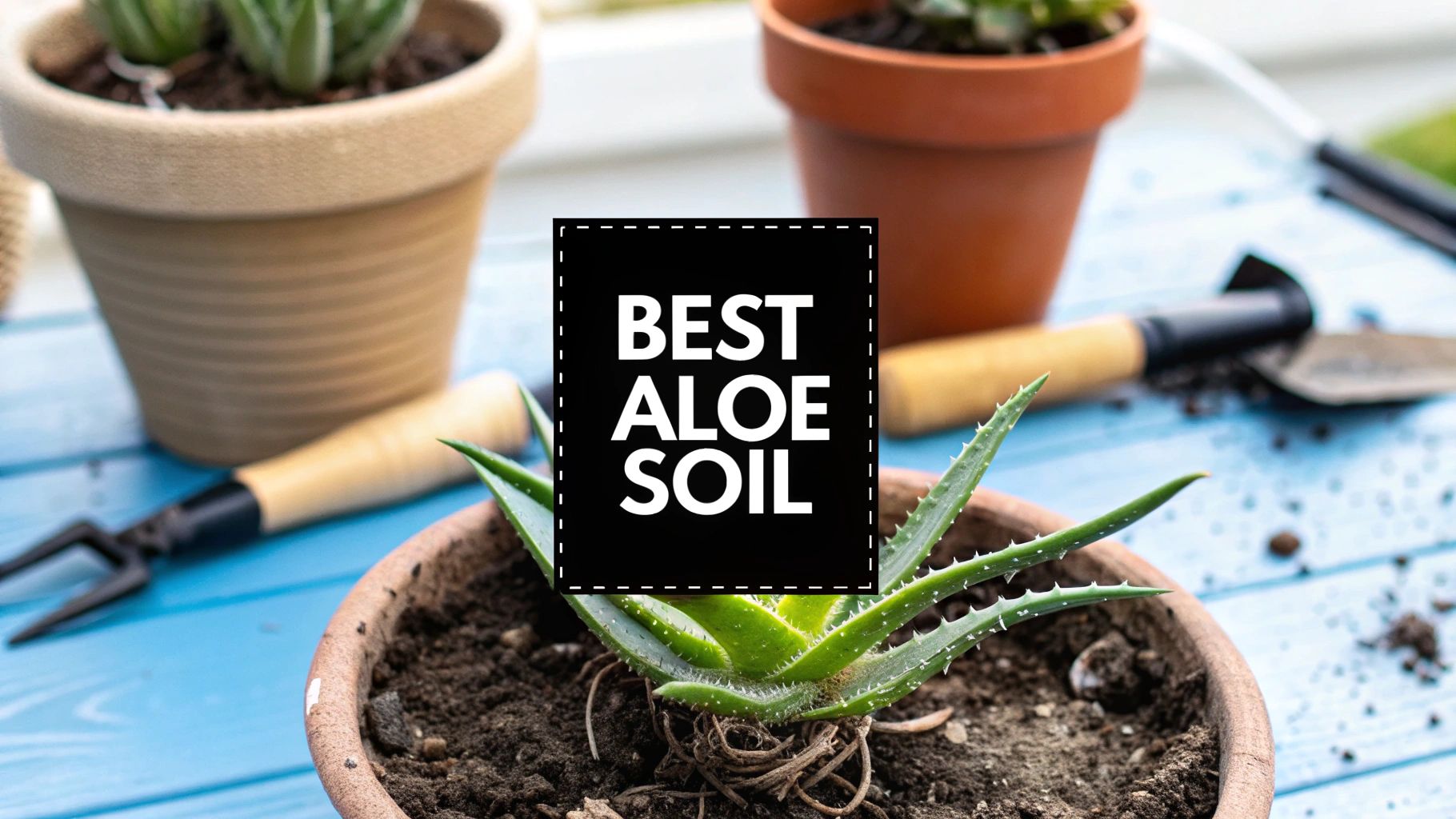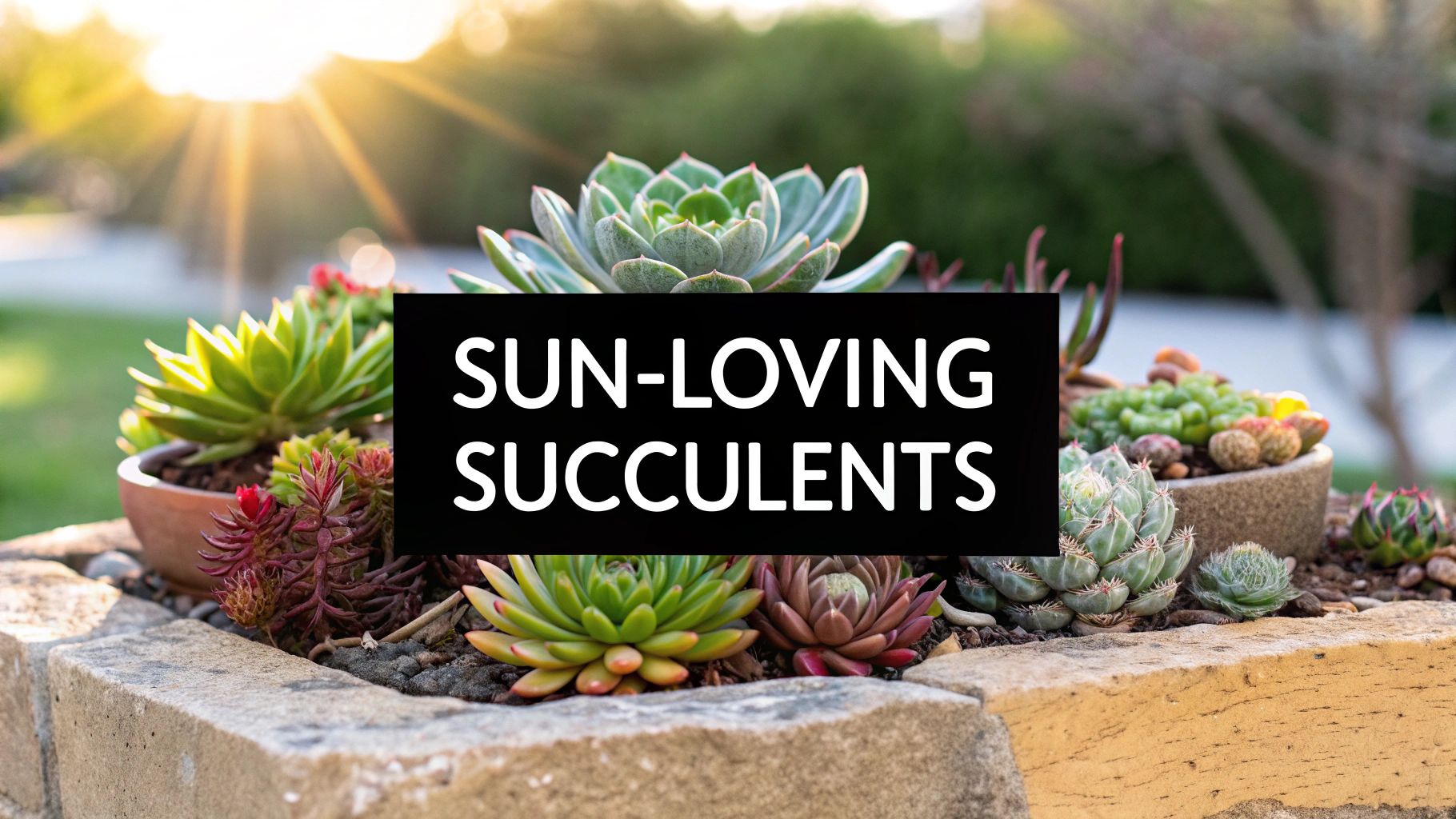When it comes to saguaro cactus growth, "slow and steady" is an understatement. These icons of the desert are a true lesson in patience. In its first decade of life, a young saguaro might only grow between 1 and 1.5 inches.
To put that into perspective, a ten-year-old saguaro might still be small enough to hide in the palm of your hand.
Unlocking the Saguaro Growth Timeline
Thinking in decades, not years, is the only way to truly appreciate a saguaro's journey. This incredibly slow start is a brilliant survival tactic baked into its DNA, perfectly suited for the harsh Sonoran Desert where every drop of water and ounce of energy counts.
This strategy allows the young cactus to pour all its resources into building a robust root system before it even thinks about growing tall. It’s a crucial foundation for a life that can span over 150 years. You can learn more about these incredible desert adaptations on Green Living Mag.
Saguaros share the desert with many other types of large cactus plants, but their growth timeline is uniquely their own. Each stage of development comes with its own pace and distinct milestones.
The saguaro's journey from a tiny seed to a towering icon is a masterclass in endurance. Each inch of growth represents a quiet victory over extreme heat, prolonged drought, and ever-present threats.
To give you a clearer picture, here’s a breakdown of what to expect as a saguaro ages.
Saguaro Growth Rate at a Glance
This table offers a quick summary of the key phases in a saguaro's long life, showing just how much time it takes to reach those iconic milestones.
| Age Range (Years) | Approximate Height | Key Milestone |
|---|---|---|
| 0 - 10 | 1-2 inches | Establishing roots; highly vulnerable. |
| 10 - 30 | Up to 3 feet | Growth begins to accelerate slightly. |
| 30 - 50 | 6-10 feet | Reaches maturity and begins to flower. |
| 50 - 75 | 10-20 feet | First arms may begin to appear. |
| 75+ | 20-40+ feet | Continued arm growth and towering height. |
As you can see, the first arms—the feature most people associate with saguaros—often don't even start to appear until the cactus is over 50 years old. It's a powerful reminder of just how ancient the giants we see in the desert truly are.
The Life Story of a Saguaro Cactus
Tracking a saguaro's growth is like watching a story unfold in slow motion, with each new chapter taking decades to write. It all starts with a seed no bigger than a pinhead, facing a tough start in the Sonoran Desert. For the first several years, a tiny saguaro is completely reliant on a nurse plant—often a palo verde or mesquite tree—to survive.
This natural umbrella protects the seedling from the harsh desert sun and brutal freezes. In these early years, growth is almost unnoticeable. The cactus pours all its energy into its roots, building a strong foundation for the long life ahead. A ten-year-old saguaro might be just one or two inches tall, a perfect example of patience.
The Teenage Growth Spurt
After around 30 years, the saguaro finally hits its version of a growth spurt. Now strong enough to stand on its own, its vertical growth really picks up, adding several inches a year. This is when you start to see that classic, ribbed column shape take form as it prepares for the next major phase of its life.
The timeline below really puts into perspective just how long these milestones take.
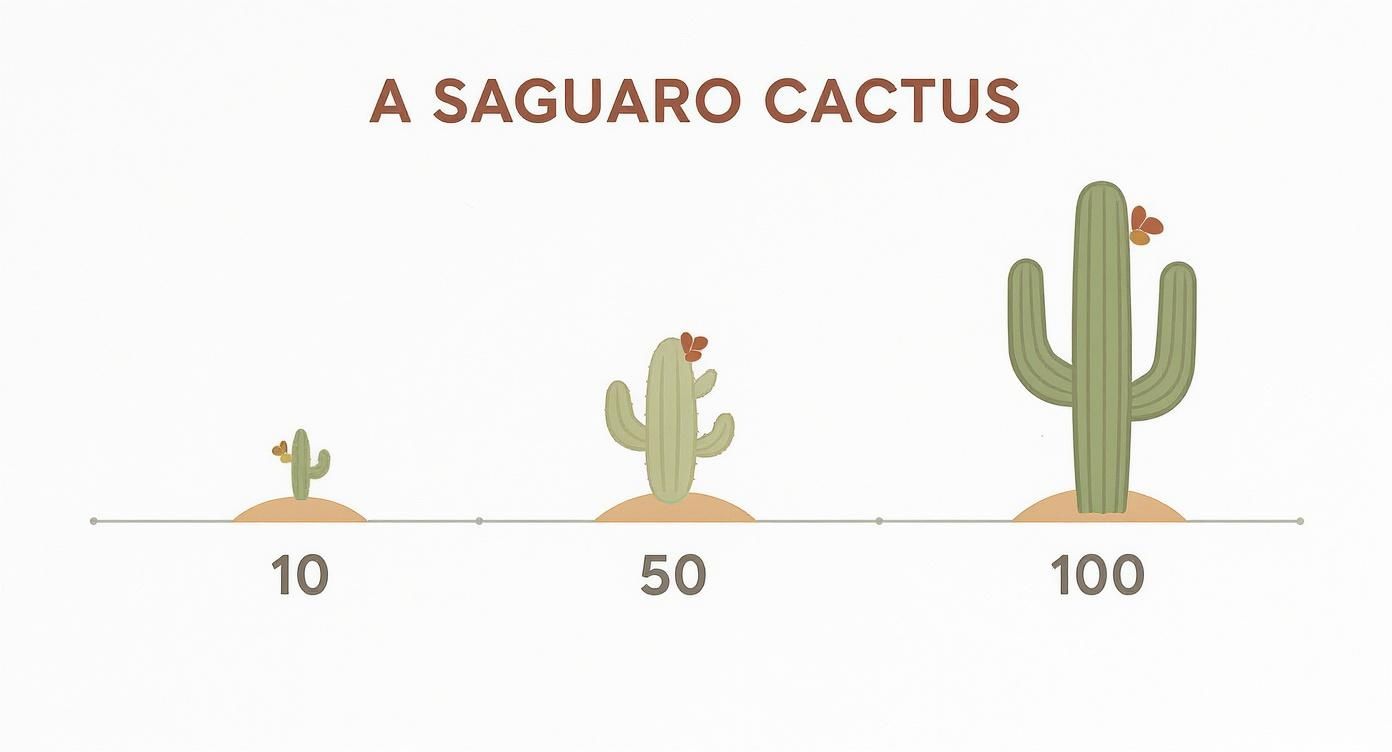
As you can see, the iconic arms—a true sign of maturity—might not even show up for more than half a century. It's a long journey.
Adulthood and Reproduction
A saguaro is considered mature somewhere between 30 and 50 years old. This is when it first produces its stunning white flowers that open up at night. Once flowering begins, its priorities change dramatically. A massive amount of its energy, sometimes up to 50%, gets redirected from vertical growth into producing flowers, fruit, and seeds. You can dive deeper into this reproductive stage with these findings from the National Park Service.
Then comes the moment everyone waits for: the growth of its first arm. This usually happens when the cactus is between 50 and 75 years old. These incredible arms give it more surface area for photosynthesis and boost its ability to reproduce, finally transforming it into that symbol of the desert we all recognize.
What Controls Saguaro Growth
The saguaro’s incredibly slow growth isn’t a defect; it’s a brilliant survival strategy, perfectly adapted to a harsh world. Think of its growth rate as being controlled by a series of environmental dials—water, temperature, and sunlight—that determine just how fast these desert giants can reach for the sky.
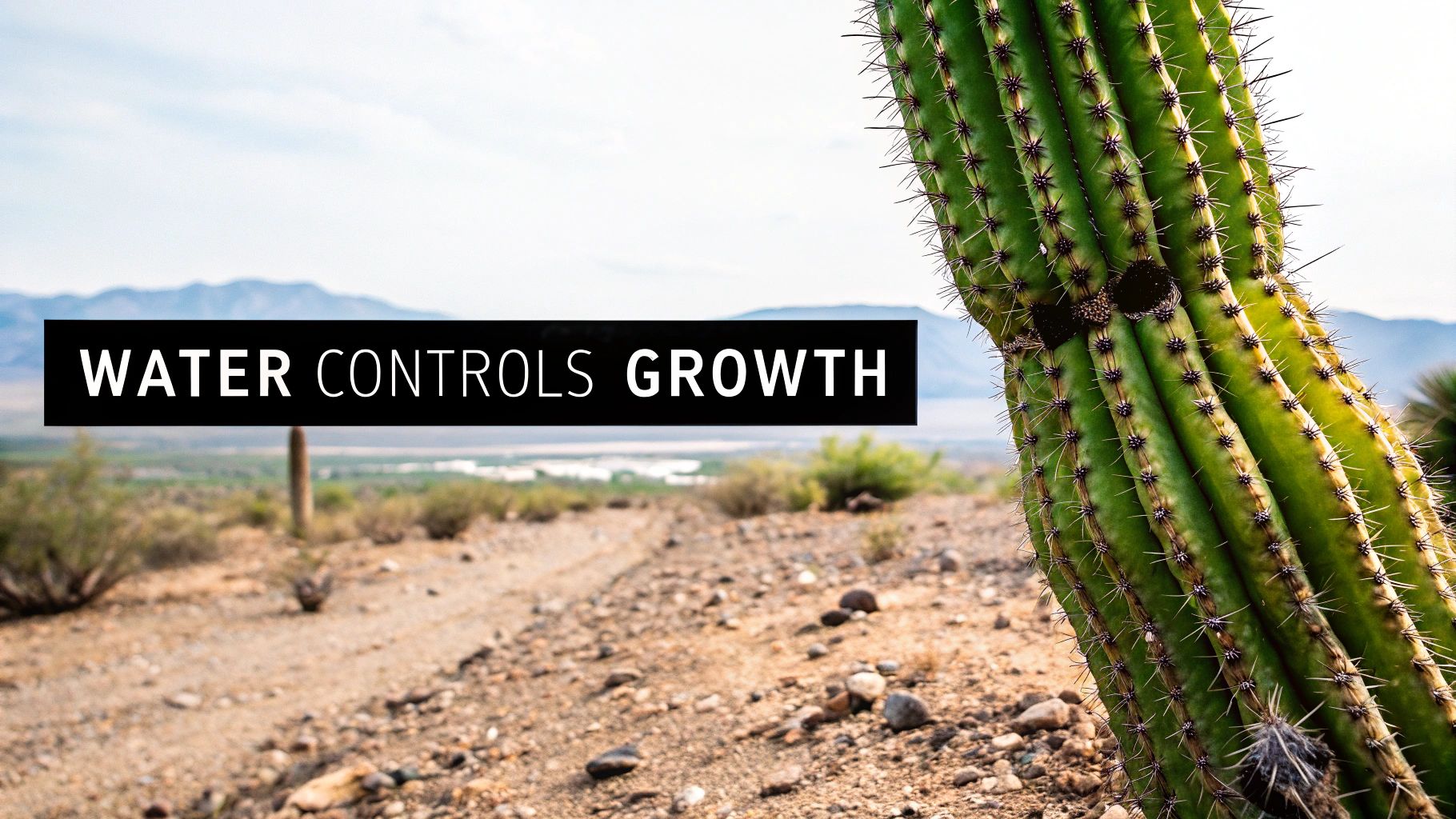
When it comes to these dials, water is king. A saguaro is a master of water conservation. Its iconic, accordion-like ribs are designed to swell dramatically after a good rain, letting the cactus soak up a staggering amount of water to ride out the long, dry spells.
In fact, a saguaro can absorb so much water that its total weight can increase by a huge margin. This precious reserve is the fuel for everything—from adding height to its main stem to eventually growing its signature arms.
Climate and Protective Cover
Water might be the fuel, but climate sets the pace, especially for a young saguaro. The Sonoran Desert throws everything at it, from blistering summer sun to freezing winter nights. This is where a "nurse plant" becomes a lifesaver.
A young saguaro’s survival often depends on the shade of a larger plant, like a palo verde or mesquite tree. This natural guardian shields it from the most intense sun and provides a microclimate that buffers it against deadly frost.
This dependency is a big reason why the early years show such slow progress. The tiny cactus pours all its energy into just surviving, waiting until it's tough enough to face the elements on its own. The key factors really boil down to a few critical things:
- Water Availability: This is the most important factor, bar none. Consistent rainfall, especially from the summer monsoons, directly translates to faster growth.
- Temperature Extremes: Young saguaros are incredibly vulnerable to the cold. A single hard freeze can easily kill a seedling, making the protection of a nurse plant absolutely vital.
- Sunlight Exposure: While saguaros are sun-lovers, the intense desert sun can scorch a defenseless seedling. Filtered light is the ideal nursery condition for its first few years.
- Soil Quality: Saguaros need loose, well-draining soil. If their roots sit in water, they’ll rot. Compacted or clay-heavy soil is a death sentence.
Ultimately, a saguaro’s growth rate is a direct story of its environment. Every inch it gains is a hard-won victory, a testament to its patience in one of the planet’s most unforgiving climates.
How Location Affects Saguaro Development
You might be surprised to learn that not all saguaros grow at the same pace. Where a saguaro puts down its roots in the Sonoran Desert plays a massive role in its life story. The key ingredient? Water.
A saguaro growing in the eastern part of the desert, near Tucson, often experiences a very different life from one in the drier, western areas bordering California. The eastern region gets more reliable summer monsoon rains, which is like giving the cactus a consistent source of fuel for growth. This extra moisture directly supercharges the saguaro cactus growth rate.
East vs. West Growth Patterns
In the wetter eastern zones, saguaros tend to grow faster and sprout their first arms much earlier. We're not talking a small difference either—they can branch out years, or even decades, before their cousins in the parched west.
A saguaro's location is like its unique instruction manual for growth. Abundant water unlocks faster development, while scarcity demands extreme patience and conservation, creating distinct regional growth patterns.
This isn't just a casual observation. Research backs it up, confirming that saguaros in these wetter areas have higher apical growth rates and are far more likely to have multiple arms. If you want to dive deep into the science, you can explore the data in this detailed report from the USDA Forest Service.
The table below breaks down these fascinating regional differences.
Saguaro Growth East vs West Sonoran Desert
| Characteristic | Eastern Sonoran Desert (Higher Rainfall) | Western Sonoran Desert (Lower Rainfall) |
|---|---|---|
| Growth Rate | Significantly faster | Much slower, more conservative |
| First Arms | Appear earlier in life | Appear much later, if at all |
| Overall Size | Tend to be larger and more robust | Often smaller and more slender |
| Branching | Higher frequency of multiple arms | Lower frequency; many remain single-stemmed |
Ultimately, this shows the saguaro's incredible ability to adapt. While genetics provide the blueprint, the local climate acts as the lead architect.
The saguaro is just one of the many amazing cacti of the Sonoran Desert, each with a unique survival strategy. For the saguaro, having more water simply means it has more resources to build with, allowing it to hit key milestones like flowering and growing arms much sooner.
Caring for a Saguaro at Home
You can’t make a saguaro grow faster—that’s just not how they work. But what you can do is create the perfect environment to keep it healthy and strong for the long haul. Think of it less like typical gardening and more like being a caretaker for a tiny, self-sufficient piece of the Sonoran Desert.
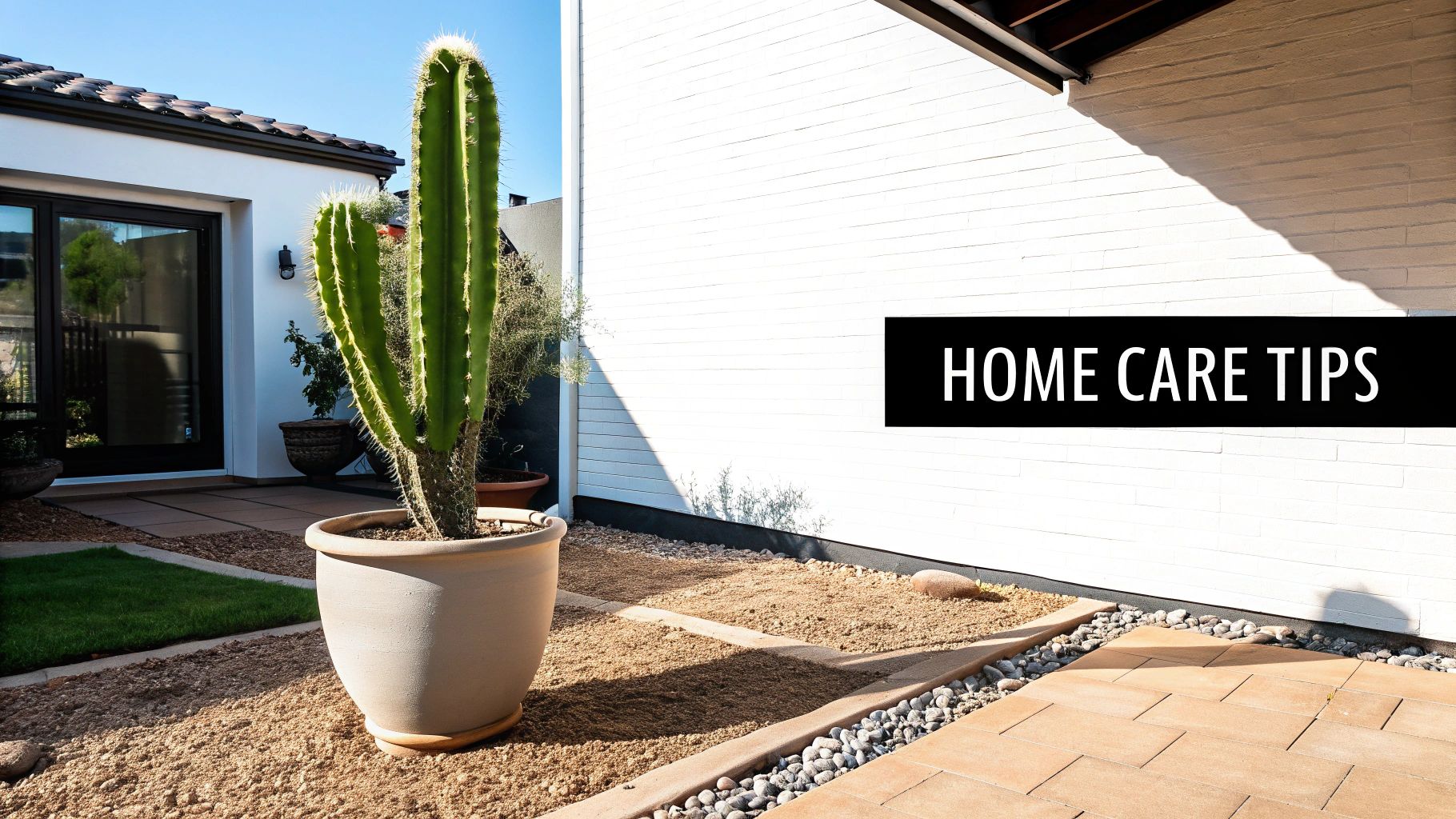
The number one mistake people make? Too much water. A saguaro’s accordion-like ribs are built to expand and store water for months, so it’s adapted for long periods of drought. Stick to a "drench and dry" schedule.
During the hottest, driest parts of summer, a deep watering about once a month is all it needs. As soon as the monsoon rains arrive, or during the cooler fall and winter months, you can stop watering altogether. Nature will take care of it.
Setting Your Saguaro Up for Success
Getting the location and soil right from the start is just as important as your watering habits. Saguaros are sun-worshippers and need a spot with full sun exposure to truly flourish.
Surprisingly, they can be a bit sensitive to frost, especially when they're young. A great trick is to plant them on the south-facing side of your house, which creates a warmer microclimate and can shield them from the worst of a cold snap.
Soil is the other half of the equation. Saguaros hate having "wet feet," which is a surefire way to cause root rot. The soil has to be loose and sandy, letting water drain away quickly instead of sitting around the base. If you're dealing with heavy clay soil, you’ll need to amend it with plenty of sand and gravel to mimic its natural desert floor.
The goal isn't to force a saguaro to grow faster. It's about removing any obstacles in its way. When you replicate its native Sonoran home with the right sun, soil, and water, you’re letting the cactus grow at the slow, steady, and healthy pace it was meant to.
If you're planning a full desert landscape, this Peoria backyard desert landscape guide is a fantastic resource for creating an authentic and thriving habitat.
Giving a saguaro a home is a commitment to its natural timeline. For a complete rundown on long-term care, check out our in-depth saguaro cactus care guide. By sticking to these basic principles, you can create a stable, supportive environment where this desert icon can grow for generations.
Answering Your Top Saguaro Questions
Even after learning about the saguaro's fascinating life, a few questions always seem to pop up. Let's tackle some of the most common ones to give you a clearer picture of this iconic desert survivor.
When Do Saguaros Get Their Arms?
This is the big one, and the answer really speaks to the saguaro's patient journey. A saguaro typically sprouts its first arm somewhere between 50 and 75 years old. But even that isn't a hard and fast rule.
Some saguaros, especially those in very dry or harsh parts of the desert, might never grow arms at all. They have to pour every last bit of energy into just staying alive. So, when you see those first arms appear, it’s a sign of a healthy, successful cactus with enough water and energy to spare for expansion.
The growth of a saguaro's first arm is a huge milestone. It’s the cactus signaling it has moved beyond simple survival and is mature enough to invest in its future.
What Is the Maximum Height of a Saguaro?
As the largest cactus in the United States, saguaros can reach staggering heights. The average mature saguaro you see will be around 40 feet tall, but some true giants have been known to stretch over 60 feet. The tallest one ever measured was a massive 78 feet tall before it toppled in a storm back in 1986.
Getting that tall takes well over a hundred years. It's a true testament to finding the perfect growing spot and having a good bit of luck along the way.
Can You Grow a Saguaro Cactus Indoors?
Technically, you can start a saguaro indoors. A tiny seedling will happily live in a pot for its first decade. But as a long-term plan, it's just not practical. These cacti are fundamentally wired for the desert.
Trying to keep one indoors for the long haul presents a few major roadblocks:
- Sunlight: Saguaros crave intense, direct sun that even the best grow lights can't fully replicate.
- Size: Think about it—even a "teenage" 30-year-old saguaro would be far too big for most rooms.
- Dormancy: They rely on the natural temperature swings between seasons to trigger their growth and rest cycles, something a stable indoor climate can't provide.
At the end of the day, a saguaro is a wild giant of the Sonoran Desert. While you can certainly care for one in a backyard landscape if you live in the right climate, their true home will always be under the wide-open desert sky.
At The Cactus Outlet, we share your passion for these incredible desert plants. Whether you're a seasoned collector or just starting your journey, we have a wide selection of healthy, beautiful cacti to bring a piece of the desert to your home. Explore our collection of large cacti and find your next statement piece today. Shop now at The Cactus Outlet


